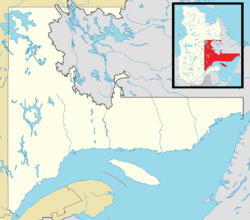Caniapiscau | |
|---|---|
 Caniapiscau Reservoir | |
| Coordinates: 54°52′N 69°55′W / 54.867°N 69.917°W[1] | |
| Country | Canada |
| Province | Quebec |
| Region | Côte-Nord |
| RCM | Caniapiscau |
| Constituted | unspecified |
| Government | |
| • Federal riding | Manicouagan |
| • Prov. riding | Duplessis |
| Area | |
| • Total | 40,577.46 km2 (15,667.04 sq mi) |
| • Land | 30,108.23 km2 (11,624.85 sq mi) |
| Population | |
| • Total | 0 |
| • Density | 0.0/km2 (0/sq mi) |
| • Pop (2016-21) | |
| • Dwellings | 0 |
| Time zone | UTC-5 (EST) |
| • Summer (DST) | UTC-4 (EDT) |
| Highways | No major routes |
Caniapiscau (English: /ˌkæniəˈpɪskoʊ/) is a vast unorganized territory in the Côte-Nord region of Quebec, Canada, part of Caniapiscau Regional County Municipality.
The territory is home to the huge Caniapiscau Reservoir, the largest body of water in Quebec and the second-largest reservoir in Canada. The reservoir was named after Lake Caniapiscau that was flooded in 1981 during the formation of the reservoir. The name comes from the Cree or Innu term kaniapiskau or kaneapiskak which means "rocky point" or "place where there is a rocky point". Albert Peter Low had noted in 1895 that "a high rocky headland jutts into the lake." He probably referred to the northwest facing peninsula that gives the reservoir the shape of an arc as we know it now.[4]
In the 19th century, Lake Caniapiscau was frequented by hunters and fur traders. In 1834, the Hudson's Bay Company opened there an outpost to link its facilities in the James Bay region with those of Ungava Bay. The Kaniapiskau Post closed in 1870.[4]
- ^ Cite error: The named reference
toponymiewas invoked but never defined (see the help page). - ^ a b "Répertoire des municipalités: Geographic code 97908". www.mamh.gouv.qc.ca (in French). Ministère des Affaires municipales et de l'Habitation. Retrieved 2024-04-30.
- ^ a b "Caniapiscau, Quebec (Code 2497908) Census Profile". 2021 census. Government of Canada - Statistics Canada. Retrieved 2024-04-30.
- ^ a b "Réservoir de Caniapiscau" (in French). Commission de toponymie du Québec. Retrieved 2010-10-07.
